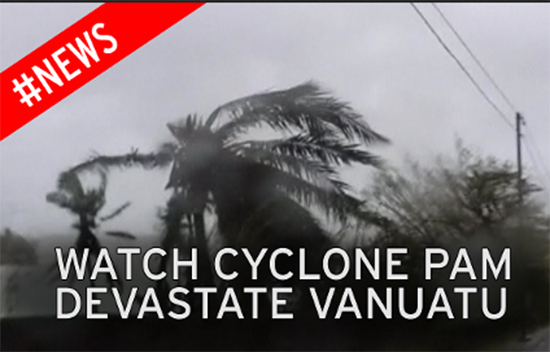
The vast gap between the relatively few of “us” safe on our sofas at home and the very large numbers of “them” out there in harm’s way is also what enables a reporter to ask a man on one of Vanuatu’s 65 isolated islands how he feels now that his home has been destroyed, his children are going hungry, everyone around him has been reduced to drinking seawater and no-one yet has come to help. The man says he feels “sadness”. By Gordon Campbell
COMMENTARY: Having media crews in a disaster zone can help to (a) pinpoint areas of need and (b) provide some re-assurance to the victims that the outside world has not entirely forgotten them. Over time, the media coverage can also motivate First World viewers and listeners to dig into their pockets and donate to relief and reconstruction projects. That’s all to the good. Vanuatu needs all the help it can get, after being hit by the worst storm in living memory.
At the same time, the fact that media crews can readily get in and out of the devastated villages in Vanuatu only underlines the chasm in the resources available. The vast gap between the relatively few of “us” safe on our sofas at home and the very large numbers of “them” out there in harm’s way is also what enables a reporter to ask a man on one of Vanuatu’s 65 isolated islands how he feels now that his home has been destroyed, his children are going hungry, everyone around him has been reduced to drinking seawater and no-one yet has come to help. The man says he feels “sadness”.
The term for this particular process is “disaster porn". That’s what happens when someone else’s misery is pimped out by the media as a form of entertainment, which we pay for by donating to charities like World Vision.
As I’ve said, the media attention and the fund-raising can be beneficial and the motives for wanting to help are genuine enough. Arguably though, there is something else we can do, beyond this vicarious circle.
Maybe we could be devoting just as much attention to the causes of the destruction in Vanuatu as we do in pawing through the physical and emotional debris afterwards.
What is causing the rise in category five weather events in the Pacific? One thing we know is that these mega-storms are increasing (a) in severity and (b) in frequency. In an article this week in New Scientist, Vanuatu’s president Baldwin Lonsdale cited climate change as a cause:
Climate change
Speaking in Japan, Lonsdale linked the cyclone Pam – and other recent cyclones – to climate change. Lonsdale said that in the past, the country was rarely hit by cyclones in March, but that it has become a regular occurrence for the last three years.
That point was repeated by World Bank vice-president Rachel Kyte, the bank’s special envoy on climate change :
Kyte agrees with Lonsdale. She says the four tropical cyclones currently threatening islands in the Indian and Pacific Oceans are “very unusual… It is very difficult to remember a time when you’ve had this frequency of such intense cyclones,” says Kyte.
In similar vein, University of Melbourne atmospheric scientist David Karoly has pointed out that two category five tropical cyclones made landfall on Australia on the same day – the first time that has ever happened. In the same New Scientist article, Kyte briefly tried to explain the processes involved:
“One of the reasons for this trend is a vastly warmer Pacific Ocean. Climate scientists in the Inter-Governmental Panel on Climate Change last year have indicated that these warmer oceans are having a profound impact on the intensity and frequency of storms and also the route that the storms are taking."
The events highlight the need for the world to take strong action on climate change, says Kyte, and if we care about those affected by Cyclone Pam, we must cut our emissions.
So… if the likes of TV3 truly care about the fate of “our neighbours” in the Pacific, maybe they should be flying into Wellington to demand what meaningful steps our government is taking (a) to cut our own emissions and (b) to use our Security Council platform to badger other countries to cut their emissions.
Bearing the brunt
As things stand, our Pacific neighbours are already bearing the brunt of First-World–induced climate change, via the damaging rise in sea levels and these unusually severe and unusually frequent storms that are hitting the region.
Not only is the incidence and severity of these storms set to increase, but poor Pacific countries are in the path that these mega-storms are being projected to follow. Would media coverage of the climate change causes of the carnage in Vanuatu be watched as avidly as the coverage of the consequences? Well, we won’t know until we try.
For now, everyone seems fairly content to continue being part of the problem, rather than spending the effort and money involved in being part of the solution.
As Greens co-leader Russel Norman said in Parliament yesterday, "Messages of condolences from this House have no meaningful effect if they are not backed by action to ensure such horrors are not repeated." Amen to that.
Gordon Campbell is a Scoop columnist and publisher of the Werewolf netzine. This article was first published here.
This work is licensed under a Creative Commons Attribution-NonCommercial 3.0 New Zealand Licence.




